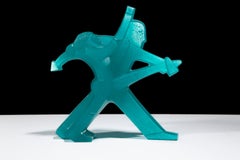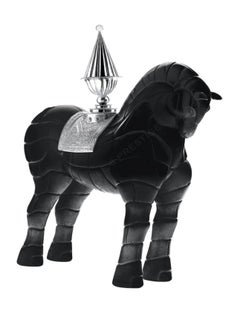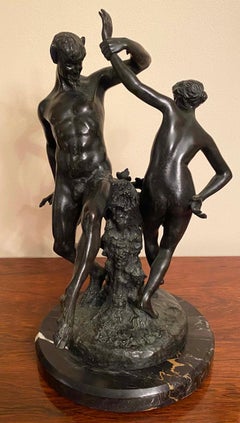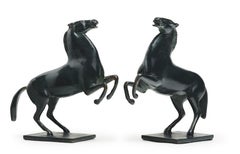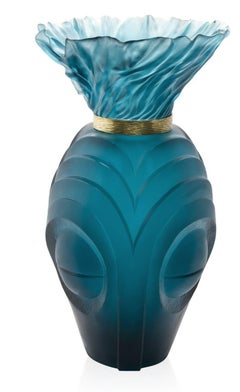Daum Sculptures
For collectors, Daum is a name in the first rank of the French makers of art glass, along with those of Émile Gallé and René Lalique. Led in its early decades by the brothers Auguste (1853–1909) and Antonin Daum (1864–1931), the company, based in the city of Nancy, established its reputation in the Art Nouveau period, and later successfully adopted the Art Deco style.
In 1878, lawyer Jean Daum took over the ownership of a glassworks as payment for a debt and installed his sons as proprietors. Initially, Daum made glass for everyday purposes such as windows, watches and tableware, but the success that Gallé enjoyed at the 1889 Universal Exposition in Paris — the international showcase for which the Eiffel Tower was built — inspired the Daum brothers to begin making art-glass pieces. They produced popular works of cameo glass, a decorative technique in which an outer layer of glass is acid-etched or carved off to reveal the layer below, but Daum became best known for vessels and sculptures in pâte de verre — a painstaking method in which finely ground colored glass is mixed with a binder, placed in a mold and then fired in a kiln.
Though early Daum glass was never signed by individual artists, the firm employed some of the masters of the naturalistic, asymmetrical Art Nouveau style, including Jacques Grüber, Henri Bergé and Amalric Walter (whose first name is frequently misspelled). Daum also collaborated with furniture and metalware designer Louis Majorelle, who created wrought-iron and brass mounts for vases and table lamps. In the 1960s, Daum commissioned fine artists, most notably Salvador Dalí and sculptor César Baldaccini, to design glass pieces. As you see from the works offered on 1stDibs, Daum has been home to an astonishingly rich roster of creative spirits and is today a state-owned enterprise making pâte de verre figurines.
1970s Daum Sculptures
Glass
20th Century Art Deco Daum Sculptures
Glass
1820s Art Deco Daum Sculptures
Bronze
1970s Art Deco Daum Sculptures
Bronze
21st Century and Contemporary Art Deco Daum Sculptures
Bronze
Early 20th Century Art Deco Daum Sculptures
Bronze
2010s Contemporary Daum Sculptures
Glass, Acrylic, Inkjet
20th Century Art Deco Daum Sculptures
Plaster, Wood
1910s Art Deco Daum Sculptures
Bronze
1930s Art Deco Daum Sculptures
Bronze
1980s Photorealist Daum Sculptures
Acrylic Polymer, Glass, Plaster
Early 20th Century Art Deco Daum Sculptures
Marble, Bronze
21st Century and Contemporary Abstract Expressionist Daum Sculptures
Glass, Blown Glass
1920s Art Deco Daum Sculptures
Bronze
21st Century and Contemporary Art Deco Daum Sculptures
Glass
Daum sculptures for sale on 1stDibs.
Artists Similar to Daum
- 1stDibs ExpertJune 6, 2024To identify Daum crystal, look for the maker's mark, usually found at the bottom of the piece. Most crystal ware produced by the luxury maker will feature the brand's logo or a hand-applied artist's signature. You can compare the markings on your piece with images featured on trusted online resources to learn more about them. Alternatively, you can consult a certified appraiser or knowledgeable antiques dealer for assistance with identification. On 1stDibs, explore a selection of Daum crystal.
- Are all Daum vases signed?1 Answer1stDibs ExpertApril 5, 2022Yes, all Daum vases are signed. Authentic Daum glass work will have the signature “Daum Nancy” and incorporate the cross of Lorraine. Looking for a signature is one of the best ways to ensure authenticity. Browse a range of authentic Daum vases and other glassware on 1stDibs.
- Is Daum crystal marked?1 Answer1stDibs ExpertMarch 15, 2024Yes, Daum crystal is typically marked. The French maker usually adds the word "Daum Nancy" and its logo, a double cross called the Cross of Lorraine, to its pieces. You can locate the mark in a discreet area, such as on the bottom of stemware and decorative objects. Find a selection of Daum Nancy crystal wares on 1stDibs.
- Is all Daum glass signed?1 Answer1stDibs ExpertMarch 22, 2022Yes, Daum glass is normally signed. The location of the company's mark varies, but it usually says "Daum Nancy" above, below or beside the cross of Lorraine, a cross with two crossbars. Find a variety of Daum glass on 1stDibs.
- How is Daum glass made?1 Answer1stDibs ExpertApril 5, 2022How Daum glass is made involves a process unique to the manufacturer, called pâte de verre. It involves filling a refractory mold with finely crushed glass and then baking the piece in a kiln. Shop a collection of Daum glassware on 1stDibs.
